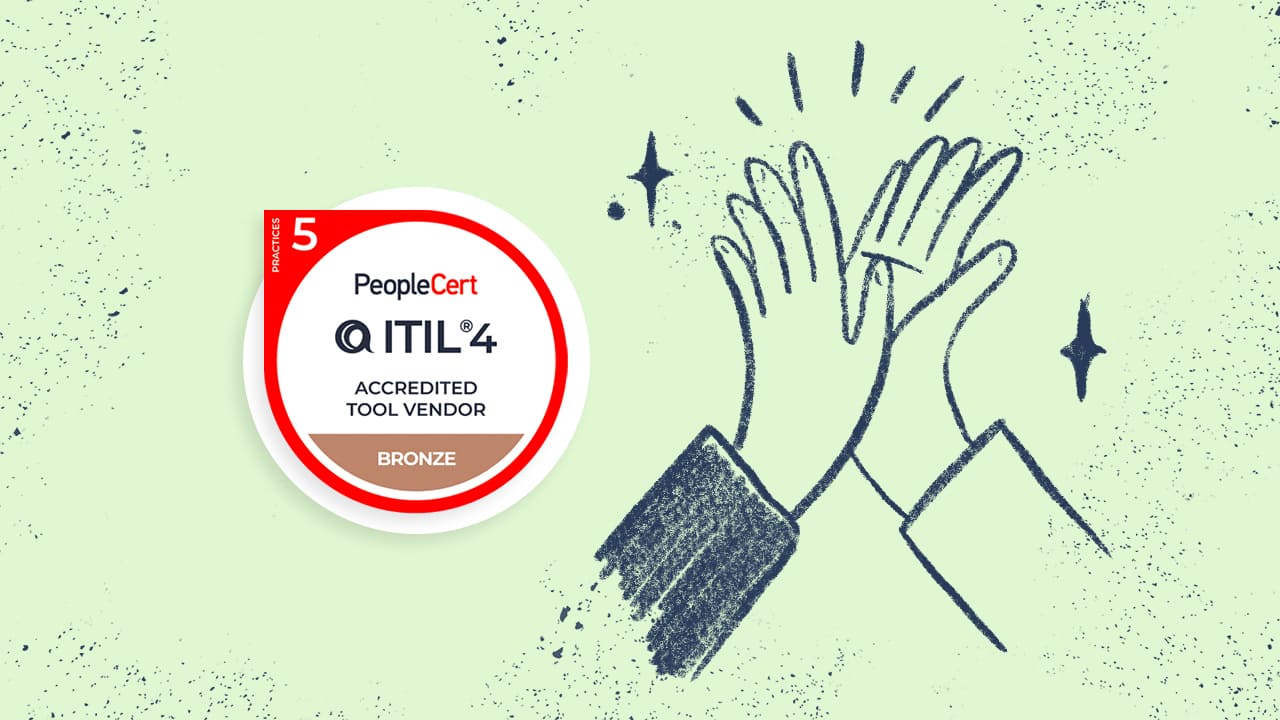Organizations constantly seek ways to enhance their service delivery and align their IT strategies with business objectives. This is where ITIL practices come into play. Formerly known as the Information Technology Infrastructure Library, ITIL has evolved into a comprehensive framework that provides best practices for IT Service Management (ITSM).
By adopting these practices, organizations can improve service quality, increase efficiency, and ultimately create more value for their customers. In this article, we will embark on a deep dive into ITIL practices, exploring their history, categories, and ITIL certifications.
Whether you're an IT professional looking to enhance your skills or a business leader aiming to optimize your IT services, this guide will provide valuable insights. So, grab a cup of coffee and let’s get started!

ITIL history
The origins of ITIL date back to the 1980s when it was first introduced by the UK government as a set of guidelines for IT Service Management. Initially focused on improving the efficiency of IT services within the public sector, ITIL quickly gained traction in the private sector as well. Over the years, ITIL has undergone several revisions, adapting to the changing landscape of technology and business needs.
In 2019, ITIL 4 was launched, marking a significant evolution from its predecessor, ITIL v3. This latest version emphasizes a more holistic approach to Service Management, integrating concepts from Agile, DevOps, and digital transformation. The shift from “processes” to “practices” reflects a broader understanding of how IT services can create value in a digital world.
What’s new with ITIL 4?
ITIL 4 introduces several key changes that enhance its relevance in today’s fast-paced environment. One of the most notable updates is the introduction of the Service Value System (SVS), which provides a comprehensive framework for value creation through Service Management. This system encompasses various components, including governance, management practices, and continual improvement, ensuring that organizations can adapt to changing demands.
Additionally, ITIL 4 emphasizes the importance of collaboration and communication among stakeholders. By promoting a culture of cooperation, organizations can better align their IT services with business goals and enhance overall performance.
What are ITIL practices?
ITIL practices are the core components of the ITIL framework, designed to help organizations effectively manage their IT services. Unlike the earlier ITIL versions that focused primarily on processes, ITIL 4 introduces a broader concept of practices that encompass a range of activities, resources, and capabilities. This shift allows organizations to adopt a more flexible and adaptive approach to service management.
At its core, ITIL 4 practices provide guidelines for managing various aspects of IT services, including incident management, change management, and service level management. By implementing these practices, organizations can streamline their operations, reduce downtime, and improve customer satisfaction.
Moreover, ITIL 4 practices are not one-size-fits-all; they can be tailored to meet the unique needs of different organizations. This adaptability makes them particularly valuable in today’s dynamic business environment, where agility and responsiveness are crucial.

ITIL 4 practices categories
To effectively manage IT services, it is essential to categorize ITIL 4 practices into distinct types. This categorization helps organizations understand the various aspects of Service Management and identify the practices that are most relevant to their needs. The three main categories of ITIL 4 practices are:
-
General Management Practices.
-
Service Management Practices.
-
Technical Management Practices.
These categories serve as a framework for organizations to implement best practices that enhance their IT service delivery.
General Management practices
General Management practices encompass a wide range of activities that support the overall management of IT services. These practices are essential for ensuring that IT aligns with business objectives and operates efficiently. The complete list of ITIL 4 general management practices includes:
-
Strategy Management: This practice focuses on aligning IT strategies with business goals to ensure that IT services contribute to overall organizational success.
-
Portfolio Management: This involves managing the organization’s portfolio of services and projects to maximize value and ensure alignment with business objectives.
-
Architecture Management: This practice ensures that the organization’s IT architecture supports its business strategy and operational needs.
-
Service Financial Management: This involves managing the financial aspects of IT services, including budgeting, accounting, and charging for services.
-
Workforce and Talent Management: This practice focuses on acquiring, developing, and retaining the talent needed to deliver IT services effectively.
-
Continual improvement: This practice emphasizes ongoing enhancements to services and processes, ensuring that organizations can adapt to changing needs and improve performance over time.
-
Measurement and reporting: This involves establishing key performance indicators (KPIs) and reporting mechanisms to track the performance of IT services.
-
Risk Management: This involves identifying, assessing, and mitigating risks that could impact IT services. By proactively managing risks, organizations can minimize disruptions and maintain service quality.
-
Information Security Management: This practice focuses on protecting the organization’s information assets and ensuring compliance with regulatory requirements.
-
Knowledge Management: This practice emphasizes the importance of capturing, sharing, and utilizing knowledge within the organization. Effective Knowledge Management enables teams to make informed decisions and improve service delivery.
-
Organizational Change Management: This involves managing the people side of change to ensure successful implementation of new processes and technologies.
-
Project Management: This practice focuses on planning, executing, and closing projects to achieve specific goals and deliver value.
-
Relationship Management: This involves managing relationships with stakeholders, including customers, suppliers, and partners, to ensure effective collaboration.
-
Supplier Management: This practice focuses on managing relationships with suppliers to ensure that they deliver value and meet contractual obligations.
Service Management practices
Service Management practices are specifically designed to manage and deliver IT services effectively. These practices ensure that services meet customer expectations and align with business goals. The complete list of ITIL 4 service management practices includes:
-
Business analysis: This practice involves understanding business needs and requirements to ensure that IT services align with organizational goals.
-
Service Catalogue Management: This practice focuses on maintaining a service catalogue that provides a single source of information on all live IT services.
-
Service design: This involves designing new or changed services to meet business requirements and ensure quality.
-
Service Level Management: This involves defining, negotiating, and monitoring service level agreements (SLAs) to ensure that services meet agreed-upon performance standards.
-
Availability Management: This practice focuses on ensuring that IT services are available and meet agreed-upon availability targets.
-
Capacity and Performance Management: This involves ensuring that IT services have the capacity to meet current and future business demands.
-
Service Continuity Management: This practice focuses on ensuring that IT services can continue to operate in the event of a disaster or major incident.
-
Monitoring and Event Management: This involves monitoring IT services and infrastructure to detect and respond to events that could impact service quality.
-
Service desk: This practice provides a single point of contact for users to report incidents and request services.
-
Incident Management: This practice focuses on restoring normal service operation as quickly as possible in the event of an incident. By effectively managing incidents, organizations can minimize downtime and enhance user satisfaction.
-
Service Request Management: This involves managing user-initiated service requests to ensure they are fulfilled efficiently and effectively.
-
Problem Management: This practice focuses on identifying and resolving the root causes of incidents to prevent recurrence.
-
Release management: This involves planning, scheduling, and controlling the movement of releases to test and live environments.
-
Change enablement: This practice is crucial for managing changes to IT services while minimizing disruption. By following a structured change management process, organizations can ensure that changes are implemented smoothly and effectively.
-
Service validation and testing: This involves ensuring that new or changed services meet business requirements and are ready for deployment.
-
Service configuration management: This practice focuses on maintaining accurate information about the configuration of IT services and their components.
-
IT Asset Management: This involves managing the lifecycle of IT assets to maximize value and ensure compliance with regulatory requirements.

Technical Management Practices
Technical Management practices focus on the technical aspects of IT Service Management. These practices ensure that the underlying technology and infrastructure support the delivery of high-quality services. The complete list of ITIL 4 technical management practices includes:
-
Deployment Management: This practice involves managing the deployment of new or changed hardware and software into the live environment. Effective deployment management ensures that services are delivered without disruption.
-
Infrastructure and Platform Management: This encompasses the management of technology resources, including servers, networks, and software, to ensure that they support business operations effectively.
-
Software Management: This practice focuses on the development and management of software applications, ensuring that they meet business needs and deliver value to customers.
ITIL Certifications
Obtaining an ITIL certification can significantly enhance an IT professional's career prospects. ITIL certifications demonstrate a thorough understanding of IT service management principles and practices, making certified individuals more attractive to employers.
The ITIL certification path is structured into several levels, starting with the ITIL Foundation certification, which provides a basic understanding of ITIL concepts. From there, professionals can pursue higher-level certifications, such as the ITIL Managing Professional and ITIL Strategic Leader certifications. These advanced certifications delve deeper into specific areas of IT service management, equipping professionals with the knowledge and skills needed to excel in their roles.
Moreover, the ITIL Master certification represents the highest level of achievement, requiring candidates to demonstrate their ability to apply ITIL principles in complex real-world situations. This certification is ideal for experienced ITSM professionals looking to validate their expertise.

Takeaways
In summary, ITIL 4 practices provide a comprehensive framework for managing IT services effectively. By understanding the history, categories, and certifications associated with ITIL, organizations can leverage these practices to enhance their service delivery and align IT with business objectives.
As businesses continue to navigate the complexities of the digital age, adopting ITIL 4 practices can lead to improved efficiency, increased customer satisfaction, and greater overall value creation.
Frequently Asked Questions (FAQs)
1. What is ITIL?
ITIL, former known as Information Technology Infrastructure Library, is a globally recognized framework for IT Service Management (ITSM) that provides best practices for managing IT services effectively.
2. What are the key benefits of ITIL 4 practices?
ITIL 4 practices help organizations improve service quality, increase efficiency, and align IT services with business objectives, ultimately creating more value for customers.
3. How can I obtain ITIL certification?
To obtain ITIL certification, individuals can start with the ITIL Foundation certification and then pursue higher-level certifications such as ITIL Managing Professional or ITIL Strategic Leader.
4. What is the difference between ITIL v3 and ITIL 4?
ITIL 4 expands the scope of ITIL v3 by introducing a more holistic approach to service management, emphasizing collaboration, value creation, and the integration of modern practices like Agile and DevOps.














.jpg?upsize=true&upscale=true&width=780&height=205&name=ITIL%20Foundation%20Exam%20(2).jpg)
